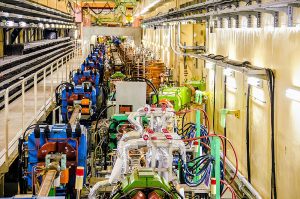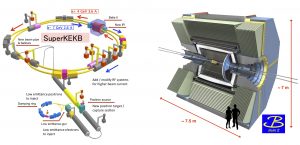 SuperKEKB , the electron–positron collider located at the KEK Laboratory (Tsukuba, Japan), on June 15th at 20:34 local time, achieved the world’s highest instantaneous luminosity, setting a record of 2.2×1034 cm-2 s-1, and thus surpassing the previous record of 2.14-1034 cm-2 s-1 obtained in 2018 by CERN’s LHC accelerator. The “luminosity” of an accelerator indicates the number of colliding particles per unit of time, per area unit (cross section), and therefore the number of events that experiments can analyze depends on its value.
SuperKEKB , the electron–positron collider located at the KEK Laboratory (Tsukuba, Japan), on June 15th at 20:34 local time, achieved the world’s highest instantaneous luminosity, setting a record of 2.2×1034 cm-2 s-1, and thus surpassing the previous record of 2.14-1034 cm-2 s-1 obtained in 2018 by CERN’s LHC accelerator. The “luminosity” of an accelerator indicates the number of colliding particles per unit of time, per area unit (cross section), and therefore the number of events that experiments can analyze depends on its value.
SuperKEKB has adopted an innovative scheme, using the concepts of “nano-beam” and “crab-waist”. Dr. Riccardo de Sangro, leader of the Frascati group of Belle II, the experiment that takes data at SuperKEKb, recalls that these are ideas conceived and developed, more than a decade ago, at the Frascati National Laboratory by the accelerator physics group, then led by Dr. Pantaleo Raimondi. The effectiveness of these new concepts in increasing luminosity, and containing the background that affects the detector, was demonstrated in 2007-2009 on the Italian DAFNE collider: DAFNE’s nano-beam and crab-waist collision schemes were then successfully integrated with the complex apparatus of the KLOE2 experiment, to which DAFNE provided data for three years.
 “The data collected so far, continues de Sangro, have already allowed Belle II to set an interesting limit in the field of dark matter research, and the first results were published in the Physical Review Letter last April. Thanks to the performance of SuperKEKB, in about 10 years of data taking Belle II will accumulate an integrated luminosity 50 times greater than the one collected by its predecessors Belle and BABAR, corresponding to the production of 50 billion pairs of B mesons. Such an abundance of data will allow the search for extremely rare events, with techniques complementary to those at the LHC, and carry out tests of unprecedented precision of theories that predict the existence of new phenomena”
“The data collected so far, continues de Sangro, have already allowed Belle II to set an interesting limit in the field of dark matter research, and the first results were published in the Physical Review Letter last April. Thanks to the performance of SuperKEKB, in about 10 years of data taking Belle II will accumulate an integrated luminosity 50 times greater than the one collected by its predecessors Belle and BABAR, corresponding to the production of 50 billion pairs of B mesons. Such an abundance of data will allow the search for extremely rare events, with techniques complementary to those at the LHC, and carry out tests of unprecedented precision of theories that predict the existence of new phenomena”
For more information, please visit the official Belle II page .
 INFN-LNF Laboratori Nazionali di Frascati
INFN-LNF Laboratori Nazionali di Frascati